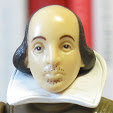 Midsummer Night’s Dream. Dir. Joe Dowling. Perf. Nic Few, Emily Swallow, Kathryn Lawrey, William Sturdivant, Jonas Goslow, Valeri Mudek, Namir Smallwood, and Stephen Pelinsky. Guthrie Theatre Company. Minneapolis. 12 April—22 June 2008.
Midsummer Night’s Dream. Dir. Joe Dowling. Perf. Nic Few, Emily Swallow, Kathryn Lawrey, William Sturdivant, Jonas Goslow, Valeri Mudek, Namir Smallwood, and Stephen Pelinsky. Guthrie Theatre Company. Minneapolis. 12 April—22 June 2008. The previous post’s title (“Second Thoughts”) made it look like I was rethinking the Guthrie’s production. Actually, I was just thinking more about the production. Sorry for any confusion that may have arisen.
I wanted to dwell briefly on the choice of putting Egeus and Demetrius in military uniforms at the beginning of the play.
At Theseus’ entrance, we hear a crowd chanting “ThesEUS . . . ThesEUS . . . ThesEUS”—it was meant to sound like the Nazi’s insane, frenzied “Sieg Heil” chant. I’m still pondering the wisdom of that choice, but it does do something to the play. We tend to turn away from Theseus from the beginning. The modern bodyguards (complete with wires running from their collars to their ears) who entered before him cast him in a similar, sinister light.
The overall impression, then, is of a dictator put in place by the military, particularly when he is so eager to support Egeus—despite Hippolyta’s obvious discomfort with Egeus’ request.
The uniforms also tie Egeus and Demetrius together immediately. We understand why Egeus prefers this one (when Lysander mentions their equal standing in respect of birth and fortune, he looks, from Egeus’ eyes, like a man who has mispent his youth and misused his birth and fortune—for Egeus, there’s a world of difference between a uniform and a hoodie, which Lysander wears at that point).
Finally, it marks the difference between Athens itself and the wood outside Athens. When both hoodie and uniform are removed, Demetrius and Lysander are able to grapple with their identites. When they return to the city, they can choose what garmets to put on.
We never see Demetrius in uniform again.
Egeus is in uniform when he finds the lovers. He marches (“marches”—ha!) offstage, never to return.
It all works—but it may work at the expense of audience affiniy with Theseus—I’m not sure he ever gains our complete respect . . . even though much of his activity is redeemed by play’s end.
The Guthrie chose to use a text based primarily on Q1 for this production. In F, Egeus, not Philostrate, gives Theseus the list of entertainments. In F, Egeus returns to the stage, and it may wrap up his attitude toward his daughter’s marriage neatly—he, too, now favors this union. Q1 is more open-ended. Egeus is a loose end.








No comments:
Post a Comment